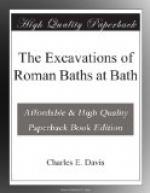The springs flooded the courts and corridors of the Thermae until the washings of the land filled them. Rushes, withies, and trees grew beneath the shadow of its ruins. Bathancastra (Akemancastra) was founded;[26] the memory of the baths was lost; its architectural magnificence was the quarry of the builders, who little dreamt that beneath the soil was buried the rich treasure which we in this century, and those who have preceded us in the last, have had the privilege of laying bare.
[Footnote 26: “The foundation of a monastery by an under-King of the Hwiccas [Osric, Nov. 6, A.D. 676,] within its walls, reveals to us the springing up of a new life in another of the cities which had been wrecked by Ceawlin’s inroad, the city of Bath.”—Green’s “Making of England,” p. 356.
Professor Earle throws some doubt on the authenticity of the record.]
The Romans left behind them in Bath a Palace of Health and Luxury unequalled except in Italy.
* * * * *
In making some excavations (1885) beneath the Cross Bath, the walls of the Roman well were found, and at a considerable depth two altars, which are placed for exhibition in the Great Bath. One of these is a plain rectangular altar; the other is carved on three sides, having on the front face two figures (AEsculapius offering a lamb to Hegiea), on another side a serpent coiled round the trunk of a tree, and on the third sculptured side a dog with a curly tail (see Professor Sayce and Rev. Preb. Scarth).
* * * * *
[Illustration]
HOT MINERAL SPRINGS
OF BATH,
VESTED IN THE CORPORATION OF THE CITY.
* * * * *
FOUNDED by the Romans in the First Century.
BATHERS DURING 1889, 104,597.
Daily yield 507,600 gallons at 120 deg. Fah.




